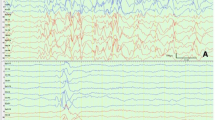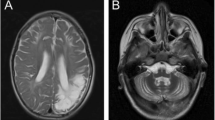Abstract
Several unrelated disorders can lead to 5-methyltetrahydrofolate (5MTHF) depletion in the cerobrospinal fluid (CSF), including primary genetic disorders in folate-related pathways or those causing defective transport across the blood-CSF barrier. We report a case of cerebral folate transport deficiency due to a novel homozygous mutation in the FOLR1 gene, in an effort to clarify phenotype–genotype correlation in this newly identified neurometabolic disorder. A previously healthy infant developed an ataxic syndrome in the second year of life, followed by choreic movements and progressive myoclonic epilepsy. At the age of 26 months, we analyzed CSF 5MTHF by HPLC with fluorescence detection and conducted magnetic resonance (MR) imaging and spectroscopy studies. Finally, we performed mutational screening in the coding region of the FOLR1 gene. MR showed a diffuse abnormal signal of the cerebral white matter, cerebellar atrophy and a reduced peak of choline in spectroscopy. A profound deficiency of CSF 5MTHF (2 nmol/L; NV 48-127) with reduced CSF/plasma folate ratio (0.4; NV 1.5-3.5) was highly suggestive of defective brain folate-specific transport across the blood-CSF/brain barrier. Mutation screening of FOLR1 revealed a new homozygous missense mutation (p.Cys105Arg) that is predicted to abolish a disulfide bond, probably necessary for the correct folding of the protein. Both parents were heterozygous carriers of the same variant. Mutation screening in the FOLR1 gene is advisable in children with profound 5MTHF deficiency and decreased CSF/serum folate ratio. Progressive ataxia and myoclonic epilepsy, together with impaired brain myelination, are clinical hallmarks of the disease.






Similar content being viewed by others
References
Aicardi J, Arzimanoglou A, Guerrini R (2004) Myoclonic epilepsies associated with progressive degenerative disorders: progressive myoclonic epilepsies. In: Aicardi J, Arzimanoglou A, Guerrini R (eds) Aicardi’s epilepsy in children. Lippincott Williams & Wilkins, Philadelphia, pp 81–87
Blau N, Bonafé L, Krägeloh-Mann I et al (2003) Cerebrospinal fluid pterins and folates in Aicardi-Goutières syndrome: a new phenotype. Neurology 61:642–647
Cario H, Bode H, Debatin KM, Opladen T, Schwarz K (2009) Congenital null mutations of the FOLR1 gene: a progressive neurologic disease and its treatment. Neurology 73:2127–2129
Fariselli P, Casadio R (2001) Prediction of disulfide connectivity in proteins. Bioinformatics 17:957–964
Garcia-Cazorla A, Quadros EV, Nascimento A et al (2008) Mitochondrial diseases associated with cerebral folate deficiency. Neurology 70:1360–1362
Mercimek-Mahmutoglu S, Stockler-Ipsiroglu S (2007) Cerebral folate deficiency and folinic acid treatment in hypomyelination with atrophy of the basal ganglia and cerebellum (H-ABC) syndrome. Tohoku J Exp Med 211:95–96
Moretti P, Peters SU, Del Gaudio D et al (2008) Brief report: autistic symptoms, developmental regression, mental retardation, epilepsy, and dyskinesias in CNS folate deficiency. J Autism Dev Disord 38:1170–1177
Opladen T, Blau N, Ramaekers VT (2010) Effect of antiepileptic drugs and reactive oxygen species on folate receptor 1 (FOLR1)-dependent 5-methyltetrahydrofolate transport. Mol Genet Metab Jun 16. In press
Ormazabal A, García-Cazorla A, Fernández Y, Fernández-Alvarez E, Campistol J, Artuch R (2005) HPLC with electrochemical and fluorescence detection procedures for the diagnosis of inborn errors of biogenic amines and pterins. J Neurosci Methods 142:153–158
Ormazabal A, García-Cazorla A, Pérez-Dueñas B et al (2006) Determination of 5-methyltetrahydrofolate in cerebrospinal fluid of paediatric patients: reference values for a paediatric population. Clin Chim Acta 371:159–162
Pineda M, Ormazabal A, López-Gallardo E et al (2006) Cerebral folate deficiency and leukoencephalopathy caused by a mitochondrial DNA deletion. Ann Neurol 59:394–398
Ramaekers VT, Rothenberg SP, Sequeira JM et al (2005) Autoantibodies to folate receptors in the cerebral folate deficiency syndrome. N Engl J Med 352:1985–1991
Serrano M, García-Silva MT, Martin-Hernandez E et al (2010) Kearns-Sayre syndrome: cerebral folate deficiency, MRI findings and new cerebrospinal fluid biochemical features. Mitochondrion Apr 11. [Epub ahead of print]
Skovby F (2003) Disorders of sulfur amino acids. In: Blau N, Duran M, Blaskovics ME, Gibson KM (eds) Physician’s guide to the laboratory diagnosis of metabolic diseases, 2nd edn. Springer, Berlin, pp 243–260
Steinfeld R, Grapp M, Kraetzner R et al (2009) Folate receptor alpha defect causes cerebral folate transport deficiency: a treatable neurodegenerative disorder associated with disturbed myelin metabolism. Am J Hum Genet 85:354–363
Surtees R (1998) Demyelination and inborn errors of the single carbon transfer pathway. Eur J Pediatr 157:S118–S121
Surtees R, Heales S, Bowron A (1994) Association of cerebrospinal fluid deficiency of 5-methyltetrahydrofolate, but not S-adenosylmethionine, with reduced concentrations of the acid metabolites of 5-hydroxytryptamine and dopamine. Clin Sci (Lond) 86:697–702
Taparia S, Gelineau-van Waes J, Rosenquist TH, Finnell RH (2007) Importance of folate-homocysteine homeostasis during early embryonic development. Clin Chem Lab Med 45:1717–1727
Temudo T, Rios M, Prior C et al (2009) Evaluation of CSF neurotransmitters and folate in 25 patients with Rett disorder and effects of treatment. Brain Dev 31:46–51
Troen AM, Chao WH, Crivello NA et al (2008) Cognitive impairment in folate-deficient rats corresponds to depleted brain phosphatidylcholine and is prevented by dietary methionine without lowering plasma homocysteine. J Nutr 138:2502–2509
Van der Knaap MS, Pouwels PJW (2005) Magnetic resonance spectroscopy: basic principles and application in white matter disorders. In: van der Knaap MS, Valk J (eds) Magnetic resonance of myelination and myelin disorders, 3rd edn. Springer, Berlin, pp 859–880
Vilaseca MA, Moyano D, Ferrer I, Artuch R (1997) Total homocysteine in pediatric patients. Clin Chem 43:690–692
Zhao R, Min SH, Wang Y, Campanella E, Low PS, Goldman ID (2009) A role for the proton-coupled folate transporter (PCFT-SLC46A1) in folate receptor-mediated endocytosis. J Biol Chem 284:4267–4274
Funding
Financial support was received from Fondo de Investigación Sanitaria (FIS) grants PI07/0548 and PS09/01132, from CIBERER, an initiative of the Instituto de Salud Carlos III, and from “Agència de Gestió d’Ajuts Universitaris i de Recerca-Agaur” (2009SGR00971). C.T. and M.S. were supported by a Biomedical Network Research Centre on Rare Diseases (CIBERER) contract.
Author information
Authors and Affiliations
Corresponding author
Additional information
Communicated by: Nenad Blau
Competing interest: None declared.
Electronic supplementary materials
Below is the link to the electronic supplementary material.
Supplementary Table 1
Primer sequences used for the PCR amplification of the FOLR1 gene coding region (exons 4 to 7). The length of the PCR products (bp) and the annealing temperatures (°C) are shown for each amplicon (DOC 32 kb)
Rights and permissions
About this article
Cite this article
Pérez-Dueñas, B., Toma, C., Ormazábal, A. et al. Progressive ataxia and myoclonic epilepsy in a patient with a homozygous mutation in the FOLR1 gene. J Inherit Metab Dis 33, 795–802 (2010). https://doi.org/10.1007/s10545-010-9196-1
Received:
Revised:
Accepted:
Published:
Issue Date:
DOI: https://doi.org/10.1007/s10545-010-9196-1




